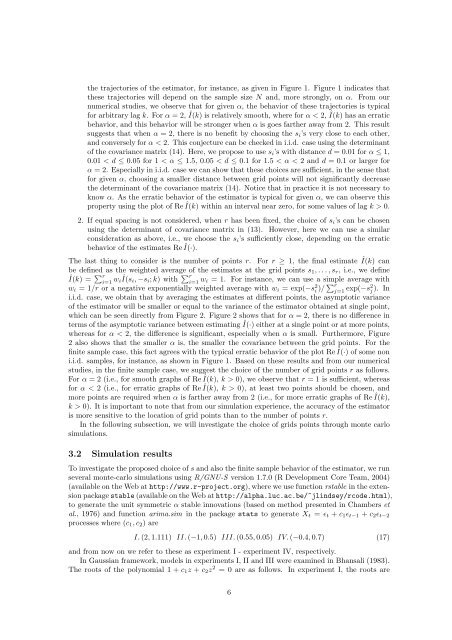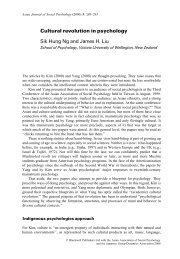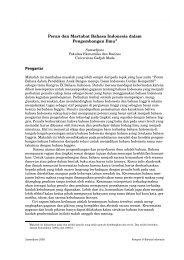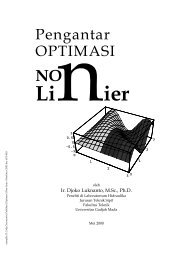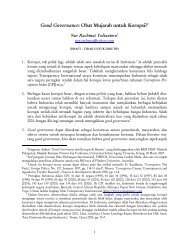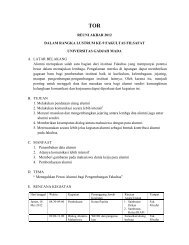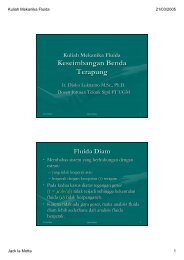Estimating the Codifference Function of Linear Time Series Models ...
Estimating the Codifference Function of Linear Time Series Models ...
Estimating the Codifference Function of Linear Time Series Models ...
Create successful ePaper yourself
Turn your PDF publications into a flip-book with our unique Google optimized e-Paper software.
<strong>the</strong> trajectories <strong>of</strong> <strong>the</strong> estimator, for instance, as given in Figure 1. Figure 1 indicates that<br />
<strong>the</strong>se trajectories will depend on <strong>the</strong> sample size N and, more strongly, on α. From our<br />
numerical studies, we observe that for given α, <strong>the</strong> behavior <strong>of</strong> <strong>the</strong>se trajectories is typical<br />
for arbitrary lag k. For α = 2, Î(k) is relatively smooth, where for α < 2, Î(k) has an erratic<br />
behavior, and this behavior will be stronger when α is goes far<strong>the</strong>r away from 2. This result<br />
suggests that when α = 2, <strong>the</strong>re is no benefit by choosing <strong>the</strong> s i ’s very close to each o<strong>the</strong>r,<br />
and conversely for α < 2. This conjecture can be checked in i.i.d. case using <strong>the</strong> determinant<br />
<strong>of</strong> <strong>the</strong> covariance matrix (14). Here, we propose to use s i ’s with distance d = 0.01 for α ≤ 1,<br />
0.01 < d ≤ 0.05 for 1 < α ≤ 1.5, 0.05 < d ≤ 0.1 for 1.5 < α < 2 and d = 0.1 or larger for<br />
α = 2. Especially in i.i.d. case we can show that <strong>the</strong>se choices are sufficient, in <strong>the</strong> sense that<br />
for given α, choosing a smaller distance between grid points will not significantly decrease<br />
<strong>the</strong> determinant <strong>of</strong> <strong>the</strong> covariance matrix (14). Notice that in practice it is not necessary to<br />
know α. As <strong>the</strong> erratic behavior <strong>of</strong> <strong>the</strong> estimator is typical for given α, we can observe this<br />
property using <strong>the</strong> plot <strong>of</strong> Re Î(k) within an interval near zero, for some values <strong>of</strong> lag k > 0.<br />
2. If equal spacing is not considered, when r has been fixed, <strong>the</strong> choice <strong>of</strong> s i ’s can be chosen<br />
using <strong>the</strong> determinant <strong>of</strong> covariance matrix in (13). However, here we can use a similar<br />
consideration as above, i.e., we choose <strong>the</strong> s i ’s sufficiently close, depending on <strong>the</strong> erratic<br />
behavior <strong>of</strong> <strong>the</strong> estimates ReÎ(·).<br />
The last thing to consider is <strong>the</strong> number <strong>of</strong> points r. For r ≥ 1, <strong>the</strong> final estimate Î(k) can<br />
be defined as <strong>the</strong> weighted average <strong>of</strong> <strong>the</strong> estimates at <strong>the</strong> grid points s 1 , . . . , s r , i.e., we define<br />
Î(k) = ∑ r<br />
i=1 wiÎ(s i, −s i ; k) with ∑ r<br />
i=1 w i = 1. For instance, we can use a simple average with<br />
w i = 1/r or a negative exponentially weighted average with w i = exp(−s 2 i )/ ∑ r<br />
j=1 exp(−s2 j ). In<br />
i.i.d. case, we obtain that by averaging <strong>the</strong> estimates at different points, <strong>the</strong> asymptotic variance<br />
<strong>of</strong> <strong>the</strong> estimator will be smaller or equal to <strong>the</strong> variance <strong>of</strong> <strong>the</strong> estimator obtained at single point,<br />
which can be seen directly from Figure 2. Figure 2 shows that for α = 2, <strong>the</strong>re is no difference in<br />
terms <strong>of</strong> <strong>the</strong> asymptotic variance between estimating Î(·) ei<strong>the</strong>r at a single point or at more points,<br />
whereas for α < 2, <strong>the</strong> difference is significant, especially when α is small. Fur<strong>the</strong>rmore, Figure<br />
2 also shows that <strong>the</strong> smaller α is, <strong>the</strong> smaller <strong>the</strong> covariance between <strong>the</strong> grid points. For <strong>the</strong><br />
finite sample case, this fact agrees with <strong>the</strong> typical erratic behavior <strong>of</strong> <strong>the</strong> plot Re Î(·) <strong>of</strong> some non<br />
i.i.d. samples, for instance, as shown in Figure 1. Based on <strong>the</strong>se results and from our numerical<br />
studies, in <strong>the</strong> finite sample case, we suggest <strong>the</strong> choice <strong>of</strong> <strong>the</strong> number <strong>of</strong> grid points r as follows.<br />
For α = 2 (i.e., for smooth graphs <strong>of</strong> Re Î(k), k > 0), we observe that r = 1 is sufficient, whereas<br />
for α < 2 (i.e., for erratic graphs <strong>of</strong> Re Î(k), k > 0), at least two points should be chosen, and<br />
more points are required when α is far<strong>the</strong>r away from 2 (i.e., for more erratic graphs <strong>of</strong> Re Î(k),<br />
k > 0). It is important to note that from our simulation experience, <strong>the</strong> accuracy <strong>of</strong> <strong>the</strong> estimator<br />
is more sensitive to <strong>the</strong> location <strong>of</strong> grid points than to <strong>the</strong> number <strong>of</strong> points r.<br />
In <strong>the</strong> following subsection, we will investigate <strong>the</strong> choice <strong>of</strong> grids points through monte carlo<br />
simulations.<br />
3.2 Simulation results<br />
To investigate <strong>the</strong> proposed choice <strong>of</strong> s and also <strong>the</strong> finite sample behavior <strong>of</strong> <strong>the</strong> estimator, we run<br />
several monte-carlo simulations using R/GNU-S version 1.7.0 (R Development Core Team, 2004)<br />
(available on <strong>the</strong> Web athttp://www.r-project.org), where we use function rstable in <strong>the</strong> extension<br />
packagestable (available on <strong>the</strong> Web athttp://alpha.luc.ac.be/~jlindsey/rcode.html),<br />
to generate <strong>the</strong> unit symmetric α stable innovations (based on method presented in Chambers et<br />
al., 1976) and function arima.sim in <strong>the</strong> package stats to generate X t = ǫ t + c 1 ǫ t−1 + c 2 ǫ t−2<br />
processes where (c 1 , c 2 ) are<br />
I. (2, 1.111) II. (−1, 0.5) III.(0.55, 0.05) IV. (−0.4, 0.7) (17)<br />
and from now on we refer to <strong>the</strong>se as experiment I - experiment IV, respectively.<br />
In Gaussian framework, models in experiments I, II and III were examined in Bhansali (1983).<br />
The roots <strong>of</strong> <strong>the</strong> polynomial 1 + c 1 z + c 2 z 2 = 0 are as follows. In experiment I, <strong>the</strong> roots are<br />
6


